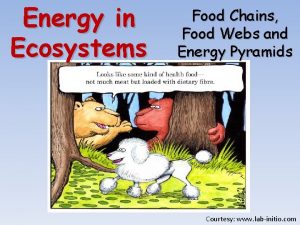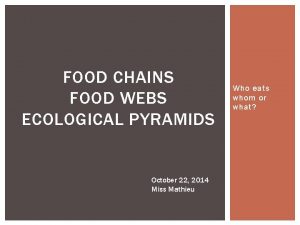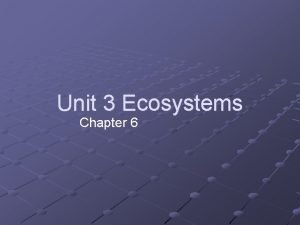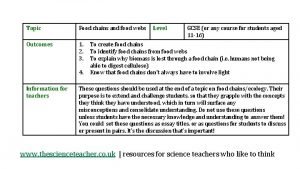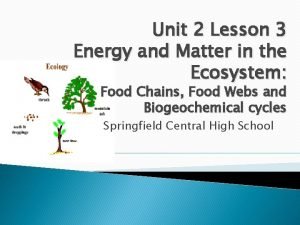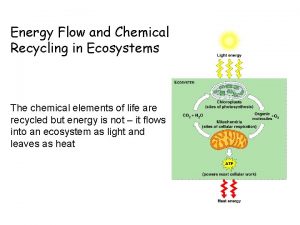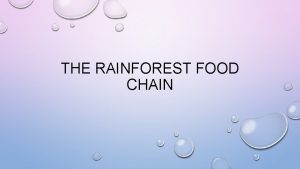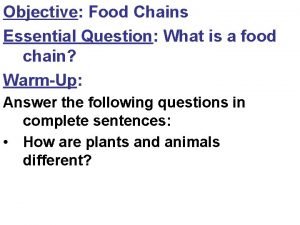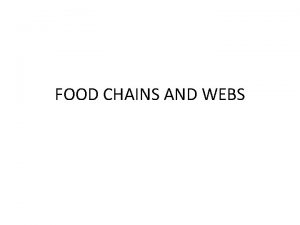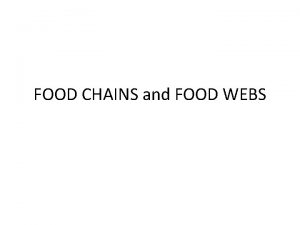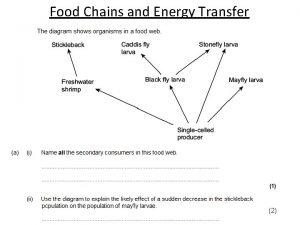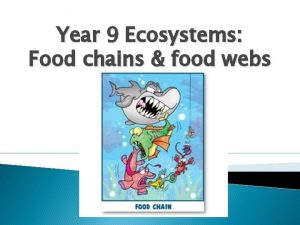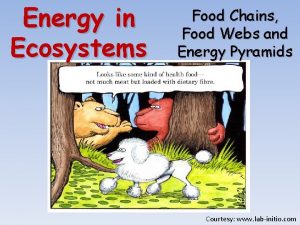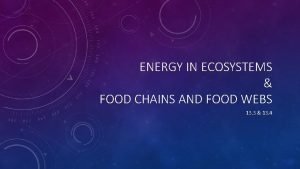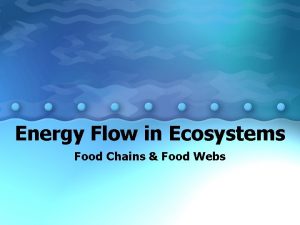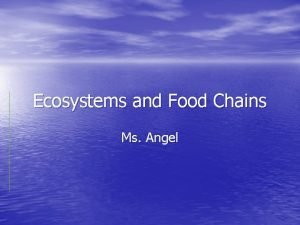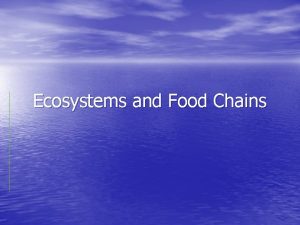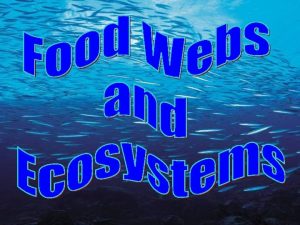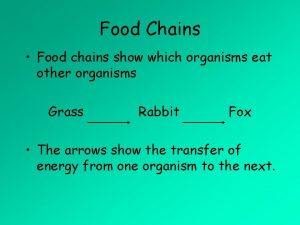5 Energy and ecosystems 5 1 Food chains
















- Slides: 16

(5) Energy and ecosystems 5. 1 Food chains and food webs

Learning objectives: • How does energy enter an ecosystem? • How is energy transferred between the organisms in the ecosystem? • What is meant by the terms: ‘trophic level’, ‘food chain’, ‘food web’, ‘producer’, ‘consumer’ and ‘decomposer’? Specification reference: 3. 4. 5

Success Criteria • I can correctly define the following key terms: Producer, Consumer, Decomposer, Detritivore, Food chain, Trophic level, Food web, Herbivore, Carnivore, Omnivore, Heterotroph, Autotroph. • I can draw and label food chains. • I can draw and label food webs. • I can answer exam questions on food chains and webs.

Starter Activity: In pairs can you define the following key terms? You have 5 minutes! • • • Producer Consumer Decomposer Detritivore Food chain Trophic level Food web Herbivore Carnivore Omnivore

Producer • Is an autotroph (organisms that can produce organic molecules from simple inorganic molecules with the aid of an additional energy source). • Producers are more specifically photoautotrophs, organisms that depend on photosynthesis i. e. manufacture substances using light energy, water and carbon dioxide. 6 CO 2 + 6 H 2 O + light energy C 6 H 12 O 6 + 6 O 2 Carbon dioxide + water + light energy glucose + oxygen • All green plants are producers.

Consumer • Is a heterotroph – an organism that gains its nutrients from complex organic molecules. These are broken down into simple soluble molecules by digestive enzymes and then built up again to form the organic molecules which the organism requires. Heterotrophs ultimately depend on autotrophs. • Simply consumers are organisms that obtain their energy by feeding on (consuming) other organisms rather than using the energy of sunlight directly. • All animals are consumers. Those that directly eat producers are primary consumers. Those eating primary consumers are called secondary consumers. Those eating secondary consumers are called tertiary consumers. Secondary and tertiary consumers are usually predators but they may also be scavengers or parasites.

Decomposer • A microorganism (bacteria and fungi) that breaks down the organic compounds in dead material and waste products into carbon dioxide, water and simple inorganic ions. Decomposition releases valuable minerals and elements in a form that can be absorbed by plants and so contribute to recycling.

Detritivore • An animal which feeds on pieces of partly broken down plant or animal tissue known as detritus. Many soil organisms such as earthworms and woodlice are detritivores. Together with decomposers, they play an important part in the cycling of soil nutrients. Detritivores break up tissue exposing a much greater surface area to attack and break down by decomposers. This increases the rate of decomposition.

Food chains • A sequence which represents the way in which energy is transferred from one organism to another in a community. An example of a food chain would be: Nettle plant large nettle aphid two-spot ladybird blue tit sparrow hawk. • Each stage in a food chain is referred to as a trophic level. The arrows in a food chain represent the direction of energy flow. Energy is lost at each stage by processes such as respiration. This means it is rare for any food chain to have more than five links. Question: Can you label the five trophic levels in the food chain above?

Activity: Complete the table below to give 3 examples of food chains. Trophic level Grassland Pond Seashore Quaternary consumer Stoat Pike Seagull Tertiary consumer Grass snake Stickleback Crab Secondary Consumer Toad Leech Whelk Primary consumer Caterpillar Water snail Limpet Producer Grass Pondweed Seaweed Toad, stoat, caterpillar, crab, leech, grass snake, pond weed, pike, seagull, stickle back, whelk, water snail, limpet, sea weed, grass The first one has been done for you!

Food webs • A diagram which shows the way in which all the different species of organism in a community depend on each other food. A food web is made up of many interconnected food chains. • Food webs can be very complex as it is likely that all organisms within a habitat, even an ecosystem, will be linked to others in the food web. Charting the feeding inter-relationships of thousands of species is not feasible. Relationships are not fixed but change depending upon the time of year, age and population size of the organisms.

Food chains can be linked to form food webs

Add these organisms to your food web. Snail Grasshopper Grass Wood mouse Beetle Owl Shrew Spider

Food chains can be linked to form food webs

You have 5 minutes to make as many different food chains as you can from your food web? 1. Grasshopper Spider Shrew Owl 2. 3. 4. 5. 6. 7. Grasshopper Spider Wood mouse Owl Grass Snail Shrew Owl Grass Beetle Spider Wood mouse Owl Grass Beetle Owl

Plenary Activity • Complete the exam question. • You are marked out of 5
 Energy flow trophic levels
Energy flow trophic levels Lab food chains and energy in ecosystems
Lab food chains and energy in ecosystems Food webs and energy pyramids worksheet answers
Food webs and energy pyramids worksheet answers Primary producers food web
Primary producers food web Food chain consumer levels
Food chain consumer levels Food chains, food webs and ecological pyramids
Food chains, food webs and ecological pyramids Dessert food chain
Dessert food chain Food chain and food web
Food chain and food web How many food chains are there in the food web
How many food chains are there in the food web How to calculate percentage energy transfer
How to calculate percentage energy transfer Food webs and energy transfer
Food webs and energy transfer Chapter 42 ecosystems and energy
Chapter 42 ecosystems and energy Phosphorus cycle
Phosphorus cycle Energy flow and chemical recycling in ecosystems
Energy flow and chemical recycling in ecosystems Rain forest food chains
Rain forest food chains What do bats eat
What do bats eat Food web secondary consumer
Food web secondary consumer

